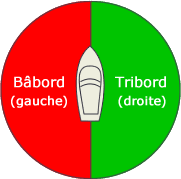
image: nageur-sauveteur
MEANINGS
The noun starboard denotes the side of a ship or aircraft that is on the right when one is facing forward, while port denotes the opposing side.
ORIGINS
From the Germanic bases of the nouns steer and board, starboard, which appeared in Old English as steorbord, denotes literally the steer board, the steer side. This side of the ship was so called with reference to the single side rudders used in early Germanic ships, which were typically suspended on the right side of the vessel for comfortable use by a right-handed helmsman.
In Old English, the name of the opposing side was bæcbord, that is, the side at the back of the steersman.
These words first appeared in the accounts of the voyages of Ohthere and Wulfstan, which were incorporated into the Old-English translation of Historiarum adversum paganos libri septem (Seven books of histories against the pagans), originally written in Latin by the Spanish priest, historian and theologian Paulus Orosius (circa 375-circa 418); for example, the account of the voyages of Ohthere contains the following:
Let him ealne weg þæt weste land on þæt steorbord, ond þa widsæ on þæt bæcbord þrie dagas.
translation:
All the way he kept the wasteland on his starboard [= his right], and the open sea on his port side [= his left] for three days.
The word bæcbord did not survive into Middle English: it was replaced by forms such as laddeborde, altered in the 16th century into ler-, leere-, larbord, by association with the contemporary ster-, steere-, starbord. Apparently, the word originally meant the side on which cargo was put aboard, its first component being supposedly connected with the verb lade, meaning to put cargo on board.
Therefore, as this side of the ship appears to have already been known as the ‘loading’ side and as such contrasted with the ‘steering’ side, it is likely that port in the sense of larboard is from the word port denoting an opening in the side of a ship for the loading and unloading of cargo. When the steering apparatus was on the right side of the vessel, the vessel would normally have been placed so as to lie with her left side alongside the quay, and any opening to allow loading would also have been on this side.
The word port in the sense of the left side when looking forward is first recorded in the High Court of Admiralty Examinations for 1543-44 in to lay the helm a-port, meaning to move the rudder to the starboard side, making the ship turn to the right.
The following is from The sea-mans dictionary, or, An exposition and demonstration of all the parts and things belonging to a shippe together with an explanation of all the termes and phrases used in the practique of navigation (1644), by the English lawyer, soldier, author, seaman and politician Sir Henry Mainwaring (1587-1653):
(1922 edition)
To Port is a word used in conding [= conducting] the ship when she is right before a wind, or if the weather sheet be aft as far as the bulkhead, which is more than quarter winds but not right afore. They will use the word ‘steady a-port,’ or ‘steady a-star-board;’ the ship ‘heels to port,’ bring things ‘over to port,’ and the like terms easily understood.
The word port was substituted for the older larboard in order to avoid misunderstandings arising from the similarity in sound of starboard and larboard. The following circular was issued by the Admiralty on 22nd November 1844:
It having been represented to the Lords Commissioners of the Admiralty, that the word ‘port’ is frequently, though not universally, substituted on board Her Majesty’s ships for the word ‘larboard,’ and as the want of a uniform practice in this respect may lead to important and serious mistakes, and as the distinction between ‘starboard’ and ‘port’ is so much more marked than that between ‘starboard’ and ‘larboard,’ it is their Lordships’ direction that the word ‘larboard’ shall no longer be used to signify left on board any of Her Majesty’s ships or vessels.
By command of their Lordships,
Sidney Herbert.
The Old-English term bæcbord did not survive, but its etymological equivalents still remain in all the modern continental Germanic tongues; for example, German uses Backbord and Dutch bakboord.
Through the earlier forms bas bord, bas-bord and basbord (due to folk-etymological association with the French adjective bas, meaning low), the French name bâbord is from Middle Dutch bakboord (the circumflex accent (^) in the current French name being a trace of the non-etymological s in bas). In Thresor de la langue francoyse tant ancienne que moderne (published in 1606), the French diplomat and scholar Jean Nicot (1530-1600/04) recorded the forms bord bas and bas bord, and their opposite estribord.
The current French equivalent of starboard is tribord, which, via earlier forms such as stribord (dictionnaire de l’Académie française – 1762), is, by metathesis (sound /tri/ for /tir/), from Middle Dutch stierboord.
